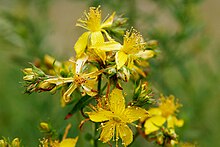| Hypericum perforatum | |
|---|---|

| |
| Scientific classification | |
| Kingdom: | Plantae |
| Clade: | Tracheophytes |
| Clade: | Angiosperms |
| Clade: | Eudicots |
| Clade: | Rosids |
| Order: | Malpighiales |
| Family: | Hypericaceae |
| Genus: | Hypericum |
| Section: | Hypericum sect. Hypericum |
| Species: | H. perforatum
|
| Binomial name | |
| Hypericum perforatum | |
| Subspecies | |
| |
| Synonyms | |
| |
Hypericum perforatum, commonly known as St John's wort (sometimes perforate St John's wort or common St John's wort), is a flowering plant in the family Hypericaceae. It is a perennial plant that grows up to 1 metre (3 ft 3 in) tall, with many yellow flowers that have clearly visible black glands around their edges, long stamens (male reproductive organs), and three pistils (female reproductive organs). Probably a hybrid between the closely related H. attenuatum and H. maculatum (imperforate St John's wort) that originated in Siberia, the species is now found worldwide. It is native to temperate regions across Eurasia and North Africa, and has been introduced to East Asia, Australia, New Zealand, and parts of North and South America. In many areas where it is not native, H. perforatum is considered a noxious weed. It densely covers open areas to the exclusion of native plants, and is poor grazing material. As such, methods for biocontrol have been introduced in an attempt to slow or reverse the spread of the species.
The species produces numerous chemical compounds that are highly active. These chemicals are harmful to large animals, especially sheep, and help to deter herbivores from consuming the plant. Other chemicals in the plant, such as hypericin and hyperforin, have various uses in medicine. St John's wort has been used in traditional medicine since at least the first century AD, often as a cure-all or panacea. The oil from its glands can be extracted, or its above-ground parts can be ground into a powder called herba hyperici. In modern times, its use as an antidepressant has been the focus of numerous studies and clinical trials; however, the active ingredients can be very harmful or even lethal when taken alongside other medicines.